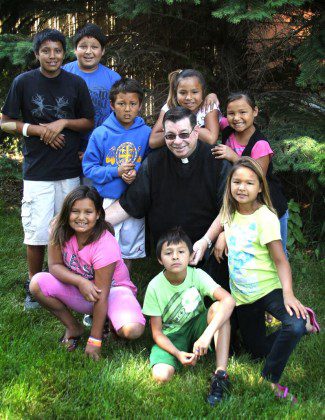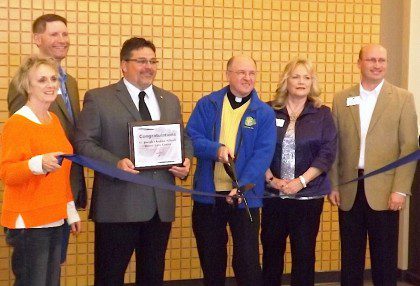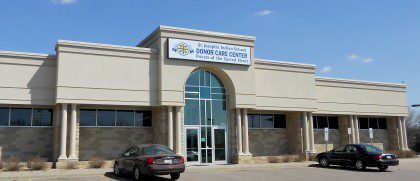
Building two-way conversations
Benefactors are key to the mission of just about any non-profit organization. No matter how good a cause, no matter how many people are helped by a program, very little happens without money.
“Donors are partners in ministry.”
It may seem like an overused phrase, but it is far from being trite. At St. Joseph’s Indian School in South Dakota (as in all SCJ ministries), benefactors are as much a part of the school’s ministry as are the teachers, house parents, administrators, maintenance staff, and even the SCJs themselves.
“Our benefactors are a part of St. Joseph’s ‘tiyospaye,’” said Fr. Anthony Kluckman, SCJ, school chaplain. “Tiyospaye “ is the Lakota word for ‘family.’ “We work together to better the lives of our children here at St. Joseph’s.”
It was in that spirit of partnership that the St. Joseph’s Donor Care Center was developed.
“Of course we want to raise money,” said Kody Christianson, manager of the Donor Care Center. “But our purpose is much more than that. The DCC mission statement calls us ‘to build meaningful relationships.’ This is more than just a ‘call center.’ Our number one goal is to build lasting relationships with our donors.”

St. Joseph’s Indian School opened the center in Sioux Falls in March, 2013. The idea came out of the school’s strategic planning process. “We came up with the idea for a donor care center as a way to focus on personal contact with our benefactors,” said Kody. “It is a way of engaging the donors in the conversation.”
No one likes the bore at the party who only talks about himself. “This is what I’m doing… this is what I plan to do.”
The Donor Call Center is a way of making it a two-way conversation. If benefactors are true partners in the ministry of St. Joseph’s Indian School, it is important to communicate WITH, not just AT them.
“The Donor Call Center enables us to more easily reach out to donors, but also for them to more easily reach out to us,” said Kody.
Those who work at the call center are also partners in the mission of St. Joseph’s Indian School. There isn’t a canned dialogue taped in front of each employee’s desk. The center’s 40 employees go through a two-week education program on school history, mission and culture. They spend time at St. Joseph’s and learn first-hand about what the school does and the children and families served by its programs.

The education process continues with weekly meetings and visits by students and alumni from the school.
“All of this is so that we can really personalize our conversations with donors.” said Kody, “Our employees are not just hired to represent the school to donors, we are all a part of the school and its mission.”
Some have asked why a donor care center for St. Joseph’s – something which is a part of the mission of the school – is located in Sioux Falls, 150 miles east of Chamberlain (the school’s location). One of the primary reasons is size. In Chamberlain, with a population of about 2,400 (and a low unemployment rate), keeping the center fully staffed would have been challenging. Eventually, Kody expects to have 60 employees at the center.
“Just as a donor halfway across the country is a part of the mission of St. Joseph’s, so are our employees at the Donor Care Center,” he said. “The location isn’t what is key to the mission of the center.”
Right now the primary method of communication is the phone. However, the center was developed with an eye on ever-changing technology. Long gone are the days when an SCJ “got phone books from cities across the country and looked up names that sounded Catholic, wrote to them about our needs in South Dakota and hoped they’d respond.”
The quote is from Fr. Tom Simcox, SCJ, who died in 2003. He was one of the province’s first fundraisers for the ministries of South Dakota. “Back then,” he added, “fund raising for religious ministries was just one step up from begging.”

Members of the center’s staff call benefactors to make sure that they know that their donations are truly appreciated. They check in to see if donors have questions about the school or its students. If a donor has asked to be removed from contact lists a representative from the center does a follow-up call –– not to be a pest, but to find out what is going on with the donor.
“Sometimes a donor has asked to be removed because he or she is going through financial difficulties,” said Kody. “We want them to know that they are still a part of our mission. If they can’t help financially, they can still support our work with prayer.”
Over and over Kody reinforced the idea that it is a donor CARE center, not call center.
“I can’t believe that you are calling just to thank me.” Kody said that he hears this over and over. “But that’s how you develop life-long relationships. The contact has to be more than a one-way conversation of ‘This is what we need, will you help us?’”
Those who work at the center understand that. “Many of our employees are people who have a strong history of giving and serving,” said Kody. “From personal experience they know the importance of a two-way conversation with organizations they support…
“It is exciting for me to work with people who seem to have found a home promoting what they love, helping to accomplish great things for the students of St. Joseph’s Indian School.
“It is exciting for me to be a part of the mission of St. Joseph’s.”

